Related Research Articles

Casimir III the Great reigned as the King of Poland from 1333 to 1370. He also later became King of Ruthenia in 1340, and fought to retain the title in the Galicia-Volhynia Wars. He was the last Polish king from the Piast dynasty.

Mary, also known as Maria of Anjou, reigned as Queen of Hungary and Croatia between 1382 and 1385, and from 1386 until her death. She was the daughter of Louis the Great, King of Hungary and Poland, and his wife, Elizabeth of Bosnia. Mary's marriage to Sigismund of Luxembourg, a member of the imperial Luxembourg dynasty, was already decided before her first birthday. A delegation of Polish prelates and lords confirmed her right to succeed her father in Poland in 1379.
Louis I, also Louis the Great or Louis the Hungarian, was King of Hungary and Croatia from 1342 and King of Poland from 1370. He was the first child of Charles I of Hungary and his wife, Elizabeth of Poland, to survive infancy. A 1338 treaty between his father and Casimir III of Poland, Louis's maternal uncle, confirmed Louis's right to inherit the Kingdom of Poland if his uncle died without a son. In exchange, Louis was obliged to assist his uncle to reoccupy the lands that Poland had lost in previous decades. He bore the title of Duke of Transylvania between 1339 and 1342 but did not administer the province.

Casimir IV was Grand Duke of Lithuania from 1440 and King of Poland from 1447 until his death in 1492. He was one of the most active Polish-Lithuanian rulers; under him, Poland defeated the Teutonic Knights in the Thirteen Years' War and recovered Pomerania.
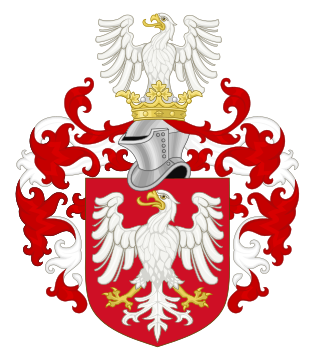
The House of Piast was the first historical ruling dynasty of Poland. The first documented Polish monarch was Duke Mieszko I. The Piasts' royal rule in Poland ended in 1370 with the death of King Casimir III the Great.
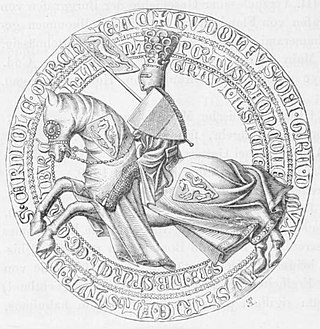
Rudolf I, also known as Rudolf of Habsburg, was a member of the House of Habsburg, the King of Bohemia and titular King of Poland from 1306 until his death. He was also Duke of Austria and Styria from 1298.
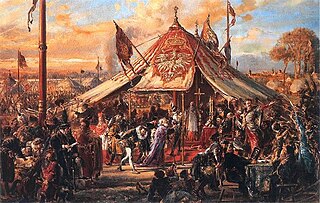
Royal elections in Poland were the elections of individual kings, rather than dynasties, to the Polish throne. Based on traditions dating to the very beginning of the Polish statehood, strengthened during the Piast and Jagiellon dynasties, they reached their final form in the Polish–Lithuanian Commonwealth period between 1572 and 1791. The "free election" was abolished by the Constitution of 3 May 1791, which established a constitutional-parliamentary monarchy.

Elizabeth of Poland was Queen of Hungary by marriage to Charles I of Hungary, and regent of Poland from 1370 to 1376 during the reign of her son Louis I.

Elizabeth of Bosnia was queen consort of Hungary and Croatia, as well as queen consort of Poland, and, after becoming widowed, the regent of Hungary and Croatia between 1382 and 1385 and in 1386.
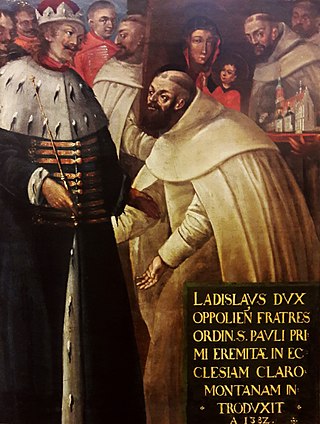
Vladislaus II of Opole, nicknamed Naderspan, was Duke of Opole from 1356, Count palatine of Hungary (1367–1372), Duke of Wieluń (1370–1392), Governor of Ruthenia (1372–1378), Count palatine of Poland (1378) as well as Duke of Dobrzyń, Inowrocław (1378–1392), Krnov and Kuyavia (1385–1392).
Bolko II the Small, was the last independent Duke of the Piast dynasty in Silesia. He was Duke of Świdnica from 1326, Duke of Jawor and Lwówek from 1346, Duke of Lusatia from 1364, Duke over half of Brzeg and Oława from 1358, Duke of Siewierz from 1359, and Duke over half of Głogów and Ścinawa from 1361.

The Capetian House of Anjou, or House of Anjou-Sicily, or House of Anjou-Naples was a royal house and cadet branch of the Capetian dynasty. It is one of three separate royal houses referred to as Angevin, meaning "from Anjou" in France. Founded by Charles I of Anjou, the youngest son of Louis VIII of France, the Capetian king first ruled the Kingdom of Sicily during the 13th century. The War of the Sicilian Vespers later forced him out of the island of Sicily, which left him with the southern half of the Italian Peninsula, the Kingdom of Naples. The house and its various branches would go on to influence much of the history of Southern and Central Europe during the Middle Ages until it became extinct in 1435.
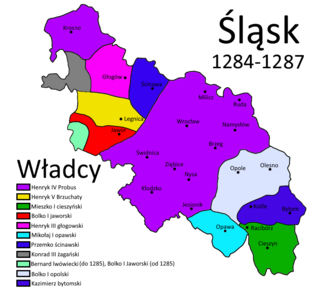
The Duchy of Bytom was a duchy in Upper Silesia, one of the Silesian duchies of fragmented Piast-ruled Poland. It was established in Upper Silesia about 1281 during the division of the Duchy of Opole and Racibórz among the sons of Duke Władysław Opolski. The duchy's capital was Bytom, formerly part of Lesser Poland until in 1177 the Polish High Duke Casimir II the Just had attached it to the Silesian Duchy of Racibórz.

The Treaty of Trencin was concluded on 24 August 1335 between King Casimir III of Poland and King John of Bohemia together with his son Margrave Charles IV. The agreement was reached by the agency of Casimir's brother-in-law King Charles I of Hungary and signed at Trencin Castle in the Kingdom of Hungary. It initiated the transfer of suzerainty over the former Polish province of Silesia to the Kingdom of Bohemia, whereafter the Duchies of Silesia were incorporated into the Bohemian Crown. Following the integration of this treaty, the three kingdoms of Bohemia, Hungary, and Poland met at the First Congress of Visegrad later in 1335 to further discuss the division of land. This congress also made the treaty official.
Catherine of Hungary was a daughter of King Charles I of Hungary. Her mother is uncertain. She was a member of the House of Anjou and was a Hungarian princess.
Hedwig of Sagan was Queen of Poland as the fourth wife of Casimir III. Casimir's lack of male heir spelled the end of the Piast dynasty in the Kingdom of Poland. After Casimir's death in 1370, she remarried Rupert I of Legnica.

The period of rule by the Piast dynasty between the 10th and 14th centuries is the first major stage of the history of the Polish state. The dynasty was founded by a series of dukes listed by the chronicler Gall Anonymous in the early 12th century: Siemowit, Lestek and Siemomysł. It was Mieszko I, the son of Siemomysł, who is now considered the proper founder of the Polish state at about 960 AD. The ruling house then remained in power in the Polish lands until 1370. Mieszko converted to Christianity of the Western Latin Church in an event known as the Baptism of Poland in 966, which established a major cultural boundary in Europe based on religion. He also completed a unification of the Lechitic tribal lands that was fundamental to the existence of the new country of Poland.

The Jagiellonian or Jagellonian dynasty, otherwise the Jagiellon dynasty, the House of Jagiellon, or simply the Jagiellons, was the name assumed by a cadet branch of the Lithuanian ducal dynasty of Gediminids upon reception by Jogaila, the Grand Duke of Lithuania, of baptism as Władysław in 1386, which paved the way to his ensuing marriage to the Queen Regnant Jadwiga of Poland, resulting in his ascension to the Crown of the Kingdom of Poland as Władysław II Jagiełło, and the effective promotion of his branch to a royal dynasty. The Jagiellons were polyglots and per historical evidence Casimir IV Jagiellon and his son Saint Casimir possibly were the last Jagiellons who spoke in their patrilineal ancestors Lithuanian language, however even the last patrilineal Jagiellonian monarch Sigismund II Augustus maintained two separate and equally lavish Lithuanian-speaking and Polish-speaking royal courts in Lithuania's capital Vilnius. The Jagiellons reigned in several European countries between the 14th and 16th centuries. Members of the dynasty were Kings of Poland (1386–1572), Grand Dukes of Lithuania, Kings of Hungary, and Kings of Bohemia and imperial electors (1471–1526).

Personal union between the Kingdom of Hungary and the Kingdom of Poland was achieved twice: under Louis I of Hungary, in 1370–1382, and under Władysław III of Poland in 1440–1444. An earlier union was also accomplished by Wenceslaus III of Bohemia for a few months in 1305, although he was heavily resisted by local nobles in both kingdoms, and gave up the Hungarian crown soon after.
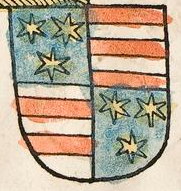
William of Celje, also William of Cilli, Count of Celje, was a Styrian nobleman who was married to Anna of Poland, daughter of the Polish king Casimir the Great. He was the co-ruler of the House of Celje together with his uncle Hermann I until 1385 and then with his cousin Hermann II until his death. William's only daughter, Anna of Celje, married the Polish King Władysław II Jagiełło in order to strengthen his claim to the Polish throne.
References
- 1 2 Davies, Norman (2005). God's Playground A History of Poland: Volume 1: The Origins to 1795. Oxford University Press. ISBN 0199253390.
- ↑ Shewring, Margaret (2010). Europa Triumphans. Ashgate Publishing, Ltd. ISBN 0754696383.
- ↑ Lukowski, Jerzy; Zawadzki, Hubert (2006). A Concise History of Poland. Cambridge University Press. ISBN 052185332X.